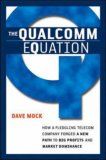 David Mock — author of The Qualcomm Equation — on Tuesday summarized the stock analyst recommendations on InterDigital Communications. InterDigital is one of the larger WCMDA patent holders — along with Qualcomm one of the few companies whose WCDMA business model is about patent royalties.
David Mock — author of The Qualcomm Equation — on Tuesday summarized the stock analyst recommendations on InterDigital Communications. InterDigital is one of the larger WCMDA patent holders — along with Qualcomm one of the few companies whose WCDMA business model is about patent royalties.The difference is that Qualcomm decided not to spin off the chip-making business (after it settled its last patent dispute with Nokia 5 years ago) and thus it has two major divisions: QTL (technology licensing) and QCT (fabless chips for CDMA, cdma2000 and WCDMA).
I had not realized that IDCC’s business model is based on large one-time settlements. Here’s how Mock explains it:
Revenue. On average, analysts look for InterDigital to report $52 million in revenue this quarter, way below the $297 million last year, but that number was inflated with a one-time gain.What was really really fascinating was the S&P summary of IDCC’s financials:
Earnings. The average analyst expectations vary wildly but average out to a $0.01-per-share loss for the quarter. …
Significant one-time settlements have anchored the bulk of InterDigital's past revenue.
12/05 | 03/06 | 06/06 | 09/06 | 12/06 | 03/07 | |
|---|---|---|---|---|---|---|
Gross | 69.7% | 73.1% | 88.4% | 89.2% | 89.4% | 88.7% |
Operating | 12.1% | 21.9% | 66.9% | 68.7% | 70.0% | 68.5% |
Net | 33.5% | 38.2% | 53.7% | 54.8% | 46.9% | 46.3% |
Motley Fool’s readers are very bullish on the stock. But from what I’ve seen, the stock has a cult following like a lot of other thinly traded stocks. IDCC is tiny compared to other 3G telecom suppliers. Qualcomm is #317 on the Fortune 500, with Motorola #61; Samsung is #63, Nokia #135 and Motorola #152 on the Forbes Global 2000).
Now IDCC wants to get into the baseband ASIC business for 2G and 3G phones — making IDCC’s business model an exact copy of Qualcomm’s. (I suppose the Qualcomm loyalists would say “a pale imitation of Qualcomm’s.”) While depressing margins, this should smooth out revenues and give somewhat of an insurance policy against patent problems going forward.
But, as Mock points out, that will put them into direct competition with Qualcomm, TI and Broadcom. Even with foundries, I would imagine such chip design is complex, and its three major rivals have a big headstart. As the newcomer, it will be interesting what sort of competitive advantage IDCC will have to offer.
Technorati Tags: 3G, business models, patents, semiconductors

No comments:
Post a Comment